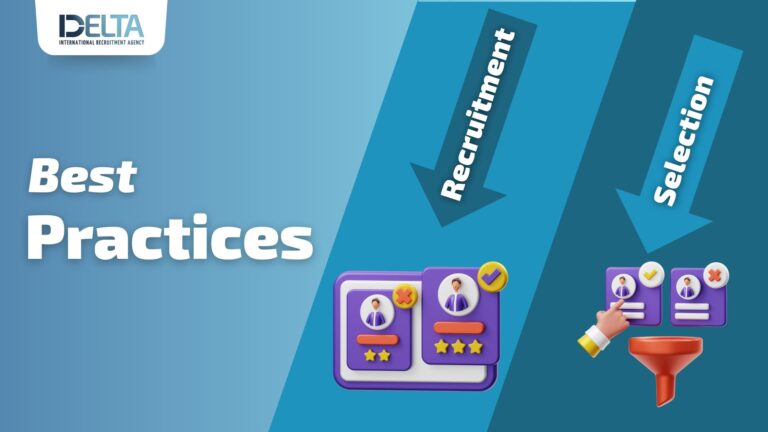An adeptly structured recruitment and selection process empowers organizations to draw in a diverse array of applicants and systematically refine the selection until the ideal candidate is identified for each position.
Let’s break it down:
Recruitment and selection serve as integral facets of the hiring journey, guiding companies to unearth and entice top-tier talent.
Recruitment entails casting the job description net far and wide, ensuring it reaches a diverse audience.
Selection, on the other hand, involves the art of narrowing down the field until you’ve pinpointed the optimal candidate for the position.
Embarking on the recruitment and selection journey involves navigating six key steps:
- Crafting a comprehensive job description
- Broadcasting the role
- Screening potential candidates
- Orchestrating interviews
- Implementing tests and assessments
- Ultimately selecting the victorious candidate.
What does “recruitment” mean?
Recruitment is how companies find and choose people for their job openings. The aim is to get many good candidates using various methods. Basically, there are two types of recruitment:
External Recruitment:
- Recruiters look for candidates outside the company.
- Methods include job sites, social media, and the company’s career site.
- Passive candidates (not actively job hunting) may also be contacted.
Internal Recruitment:
- Searching for candidates within the organization who are in different roles.
- Companies often advertise the job internally first.
- Cost-effective as promoting someone internally is usually cheaper than hiring externally
What is Selection?
Selection means figuring out which candidates are the best fit for a job by looking at their skills, knowledge, and experience. This involves talking to them in interviews and using different tests to see how good they are.
Why is Recruitment and Selection Important?
Having a good process for finding and choosing the right people for a job helps companies get the best candidates. It can lower the number of people leaving, make the work better, and even improve how much money the company makes.
How is recruiting different from picking the right person for a job?
Recruitment and selection are steps in getting new people for a job. Recruitment is like spreading the word
to many possible candidates, and selection is about finding the best one from all those interested. Here are the
main differences:
| Aspect | Recruitment | Selection |
|---|---|---|
| First Stage | Introduces the role to suitable candidates | In-depth analysis of each candidate |
| Process Type | Positive process – Aims to attract many candidates | Negative process – Aims to reject until a few remain |
| Complexity | Simpler process – Creates job description and posts | More complex process with tests and careful scrutiny |
| Time and Cost | Usually not time-consuming or expensive | Can be time-consuming and expensive |
| Relationship Establishment | Only involves communication of vacancies | Involves creating a contractual agreement |
Why Optimal Recruitment and Selection Matter
Here are four reasons why having the right way to find and choose people for jobs is crucial for a company’s success:
- Attracts the Best Talent:
A good way of finding people connects you with the top candidates.
Many good workers might not know about your job openings without your recruitment team actively reaching out.
A solid process helps convince top candidates that your company is the right fit. - Reduces Turnover and Absenteeism:
Doing it right improves how engaged employees are, lowers absenteeism, and increases how long they stay.
When you find the right person for a job, they’re more likely to do well and stick around. - Saves Money for the Company:
Having a job open for too long can cost a lot of money.
A bad hire can cost around £15,000, according to a 2017 study.
Both recruitment (finding candidates) and selection (choosing the right one) help companies save money in the long run. - Creates a Fair Chance for Everyone:
Making the recruitment and selection process formal ensures there’s no unconscious bias from hiring managers.
This gives everyone with the right skills and experience the same chance to get a job, no matter where they come from.
Recruitment and Selection process in 6 Simple Steps:
Steps Process for Recruitment and Selection
1. Create Clear Job Descriptions
Use Delta International Recruitment Agency to easily create, publish, and manage job positions. Start by crafting detailed job descriptions for each role. This is the candidate’s first glimpse into the role and your organization, so make it clear and accurate. Specify the skills and experience required to attract suitable applicants.
2. Advertise in the Right Places
Utilize Delta International Recruitment Agency to share job ads on 15+ free job boards and enhance visibility with premium campaigns on over 600 boards across Europe. Post general roles on popular job sites and social media platforms. For specialized positions, explore niche job boards. Internally, share in newsletters, emails, or physical notice boards.
3. Screen Resumes Effectively
Screen candidates without bias by removing identifying information. This ensures fair assessment based on skills and experience. Evaluate CVs or applications thoroughly to eliminate unsuitable candidates.
4. Streamline Interview Processes
Use Delta International Recruitment Agency to automate interview scheduling and focus on promising candidates. Conduct interviews to assess candidates’ capabilities and cultural fit. Depending on the role’s seniority, consider multiple interview rounds with different stakeholders.
5. Conduct Various Tests and Assessments
Determine candidates’ suitability with:
- Personality tests for soft skills
- Knowledge tests for expertise
- Psychometric tests for intelligence
- Technical skills assessments for technical abilities
6. Select and Hire the Best Candidate
Use Delta International Recruitment Agency’s Applicant’s can track Overseas recruiting services to evaluate interview and assessment results. Extend a job offer to the chosen candidate. Once accepted, sign an employment contract, and they can start after completing their notice period in their current role.
How Nonprofit Recruitment and Selection Works
Finding the right people for a nonprofit’s mission can be challenging due to limited budgets. Nonprofits need an efficient recruiting system to monitor applicants’ progress and provide quick access to information for stakeholders and interviewees.
To make the most of their limited budgets, nonprofits must track the performance of recruitment channels and adjust spending on job advertisement sites that offer the best return on investment.
Once a pool of applicants is recruited, the selection process involves decision-making to identify candidates deeply committed to the mission and likely to make a significant impact with their skills. Keeping a talent pool, even for those not hired, is valuable for future opportunities or volunteering.
In nonprofits, additional screening may include police clearance, child protection training, and other checks to ensure the safety of those being helped.
Source, Attract, and Hire Candidates with Delta International Recruitment Agency
Delta International Recruitment Agency supports nonprofits in this process, offering tools to source, attract, and hire candidates effectively. The platform allows effortless creation, publication, and management of job descriptions. With just a few clicks, jobs can be posted on 15+ free job boards. Customizable careers pages showcase the employer brand, and a convenient recruitment dashboard manages everything. The applicant tracking system (ATS) in Delta International Recruitment Agency centralizes applications from all channels, saving time through automated recruitment and selection processes.
Tips for Employers: What are Best Recruitment and Selection Practices?




 Use Cases & FAQ.jpg)